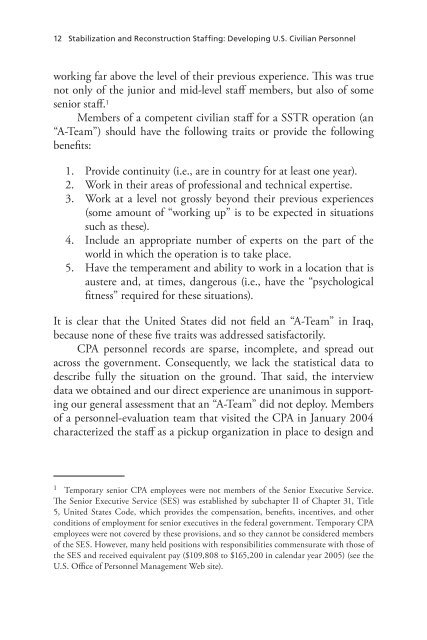Stabilization and Reconstruction Staffing - RAND Corporation
Stabilization and Reconstruction Staffing - RAND Corporation
Stabilization and Reconstruction Staffing - RAND Corporation
You also want an ePaper? Increase the reach of your titles
YUMPU automatically turns print PDFs into web optimized ePapers that Google loves.
12 <strong>Stabilization</strong> <strong>and</strong> <strong>Reconstruction</strong> <strong>Staffing</strong>: Developing U.S. Civilian Personnelworking far above the level of their previous experience. This was truenot only of the junior <strong>and</strong> mid-level staff members, but also of somesenior staff. 1Members of a competent civilian staff for a SSTR operation (an“A-Team”) should have the following traits or provide the followingbenefits:1.2.3.4.5.Provide continuity (i.e., are in country for at least one year).Work in their areas of professional <strong>and</strong> technical expertise.Work at a level not grossly beyond their previous experiences(some amount of “working up” is to be expected in situationssuch as these).Include an appropriate number of experts on the part of theworld in which the operation is to take place.Have the temperament <strong>and</strong> ability to work in a location that isaustere <strong>and</strong>, at times, dangerous (i.e., have the “psychologicalfitness” required for these situations).It is clear that the United States did not field an “A-Team” in Iraq,because none of these five traits was addressed satisfactorily.CPA personnel records are sparse, incomplete, <strong>and</strong> spread outacross the government. Consequently, we lack the statistical data todescribe fully the situation on the ground. That said, the interviewdata we obtained <strong>and</strong> our direct experience are unanimous in supportingour general assessment that an “A-Team” did not deploy. Membersof a personnel-evaluation team that visited the CPA in January 2004characterized the staff as a pickup organization in place to design <strong>and</strong>1 Temporary senior CPA employees were not members of the Senior Executive Service.The Senior Executive Service (SES) was established by subchapter II of Chapter 31, Title5, United States Code, which provides the compensation, benefits, incentives, <strong>and</strong> otherconditions of employment for senior executives in the federal government. Temporary CPAemployees were not covered by these provisions, <strong>and</strong> so they cannot be considered membersof the SES. However, many held positions with responsibilities commensurate with those ofthe SES <strong>and</strong> received equivalent pay ($109,808 to $165,200 in calendar year 2005) (see theU.S. Office of Personnel Management Web site).
















